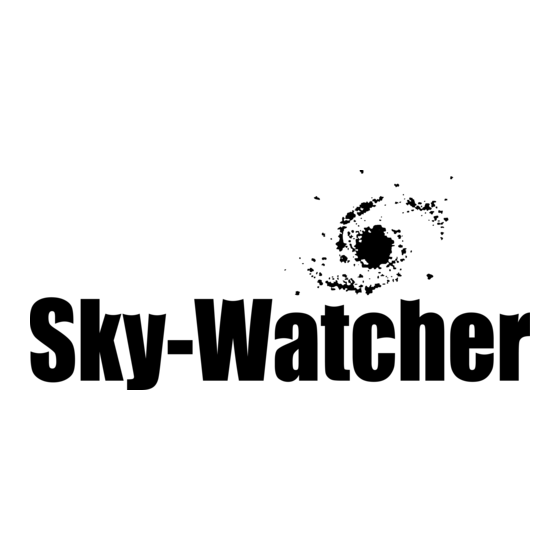
Table of Contents
Advertisement
Quick Links
Advertisement
Table of Contents

Summary of Contents for SKY-WATCHER FUSION-120i
- Page 1 INSTRUCTION MANUAL FUSION-120i Copyright © Sky-Watcher...
- Page 2 Parts Diagram Dovetail Altitude Clutch Locking Wheel Knob Dovetail Groove Bubble Level Azimuth Clutch Wheel Charge/ Power port Handcontrollerport Power Switch Auto Guider port LED Indicator USB Port...
-
Page 3: Part I : Setting Up The Fusion-120I
Put the accessory tray in between the legs and lock it in place with the washer and handwheel to be screwed on the central rod. (Fig 1.1a) Install the FUSION-120i on the tripod and secure it with the three 3/8’’ screws. (Fig 1.1b) -
Page 4: Installing The Telescope
PART I: SETTING UP THE LAZGT MOUNT 1.2 Installing The Telescope Loosen Tighten Doveltail Locking Knob Saddle Dovetail Groove Altitude Clutch Wheel Tighten Loosen Fig 1.2a Fig 1.2b 1. Loosen the altitude clutch wheel and rotate the saddle until the dovetail groove is horizontal, then tighten the altitude clutch wheel again (Fig 1.2a). -
Page 5: Panel Interface Components
Hand controller port RJ-12 for optional SynScan hand controller. 12 V DC power input for charging the internal battery and direct supply of power for operation of the FUSION-120i mount. USB port for firmware upgrade When the switch is turned off ,the green light is steady on. The charging is complete or the charging is not performed ,the green light is off.The switch is turned on the... -
Page 6: Control With A Synscan Hand Control
PART III : USING THE FUSION-120i 3.1 Manually Rotating The Mount Refer to the following diagrams: Loosen 1. Loosen the Altitude clutch wheel to manually rotate Tighten the telescope vertically. 2. Loosen the Azimuth clutch wheel to manually rotate the telescope horizontally. -
Page 7: Firmware Update
PART III : USING THE FUSION-120i 3.5 Firmware Update When a new frmware for the control board inside the mount is available, Skywatcher will release it on www.skywatcher.com. Users can visit this website to download the frmware and the necessary application to upate the frmware. -
Page 8: Specifications
APPENDI X I : SPECIFICATIONS Dimensions: 335mm 214mm 924mm Mount Tripod Specifications: Product Name FUSION-120i Mount Type Altitude-azimuth Mount 12Kg Payload Mount Weight Tripod Weight 5.8kg Power Requirement 12V-15V 2.8A DC IN Motor DC motor drive Transmission Mode Worm wheel and gear Resolution 0.085 arc-seconds... -
Page 9: Table Of Contents
CONTENT Parts Diagram PART I : SETTING UP THE FUSION-120i 1.1Setting up on a Skywatcher Tripod ................4 1.2 Installing the Telescope....................5 PART II : ELECTRONIC CONTROL INTERFACE 2.1 Panel Interface Components:...................6 2.2 External Power Supply Requirements..............6 PART III : USING THE LAZGT MOUNT 3.1 Manually Rotating the Mount .................7... -
Page 10: Part Iv: Assembling Your Telescope
PART IV: Assembling Your Telescope TELESCOPE A. Telescope Main Tube B. Dovetail C. Finderscope D. Finderscope Bracket E. Finderscope Alignment Screws F. Eyepiece G. Diagonal H. Focus knob... - Page 11 PART IV: Assembling Your Telescope Finderscope / red dot finder assembly • • mount in place. refractor Maksutov Fig.4.1.1a the rectangular slot and • Fig.4.1.2a...
-
Page 12: Eyepiece Assembly
PART IV: Assembling Your Telescope 4.2 Eyepiece assembly 1. Inserting eyepiece for refractor and Maksutov(Fig.4.2.1a) • loosen the thumbscrew on the end of the focus tube. • Insert the diagonal into the focus tube and re-tighten the thumbscrew to hold the diagonal in place. -
Page 14: Part V: Operating Your Telescope
PART V: Operating Your Telescope 5.1 Aligning and using the finderscope / red dot finder ries. When they are correctly aligned with the telescope, objects can be quickly located and for the 6x30 unscrewing it back towards the bracket. The front lens holder can now be turned in and out to focus. -
Page 15: Focusing The Telescope
PART IV: Assembling Your Telescope • Check if the plastic strip protecting the new battery has been removed. The battery is located under a cover. This location can differ in different red dot finderscope models (fig.5.1.2b). • Turn on the Red Dot Finder by rotating the variable brightness control clockwise until you hear a “click”. -
Page 16: Part Vi: Observing The Sky
PART VI: Observing the sky 6.1 Sky Conditions • steadiness of the air, and transparency, light scattering due to the amount of water va- pour and particulate material in the air. When you observe the Moon and the planets, and they appear as though water is running over them, you probably have bad “seeing” because you are observing through turbulent air. - Page 17 PART IV: Assembling Your Telescope 5.3 Choosing the appropriate eyepiece • length by the focal length of the eyepieces you are going to use. For example, a 10mm • When you are looking at astronomical objects, you are looking through a column of air that reaches to the edge of space and that column seldom stays still.
-
Page 18: Cooling The Telescope
PART VI: Observing the sky 6.4 Cooling the Telescope • Telescopes require at least 10 to 30 minutes to cool down to outside air temperature. This may take longer if there is a big difference between the temperature of the telescope and the outside air. -
Page 19: Part Vii: Proper Care For Your Telescope
PART VII: Proper Care for Your Telescope 7.1 Cleaning Your Telescope • Replace the dust cap over end of telescope whenever not in use. This prevents dust from settling on mirror or lens surface. Do not clean the telescope mirror or lens surface unless you are familiar with lens surfaces. - Page 20 FUSION-120i FUSION-120i-F-V1.0EN © 2023, Sky-Watcher, All Rights Reserved Apple, the Apple logo, iPhone, and iPod touch are trademarks of Apple Inc., registered in the U.S. and other countries. App Store is a service mark of Apple Inc. Android, Google Play and the Google Play logo are trademarks of Google Inc.





Need help?
Do you have a question about the FUSION-120i and is the answer not in the manual?
Questions and answers